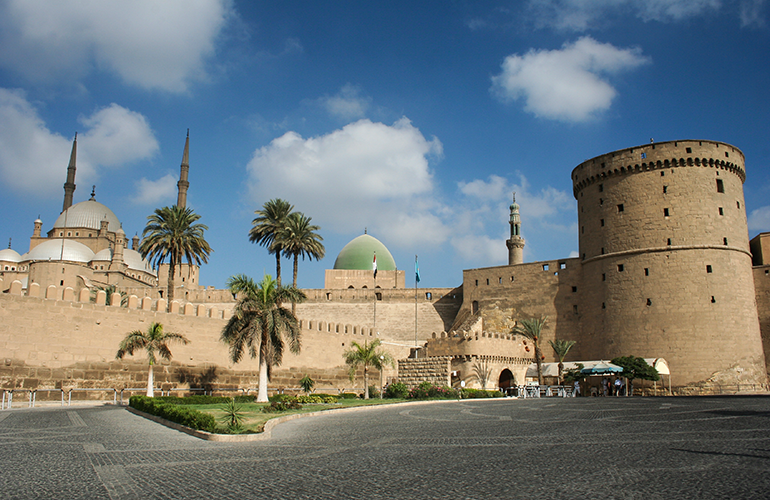The Citadel of Saladin in Egypt:

Salah El-Din (known as Saladin to European historians)
Home to Egypt’s rulers for almost 700 years, the Citadel (Al-Qalaa) is today one of the most popular tourist sites in Cairo, Saladin’s Citadel is one of Cairo’s landmarks. It is indeed from this immense and imposing fortress that Saladin, the founder of the Ayyubid dynasty, reigned over all Egypt. Built by Saladin between 1176 and 1183, it subsequently underwent numerous modifications to the sandstone of its various occupants. Saladin’s nephew had towers added to protect his residence. After defeating the Ayyubid dynasty, the Mamluks settled in the citadel, where they built the Mosque of Muhammad An-Nasir and the Qasr el-Ablaq Palace. On their arrival in the 16th century, the Ottomans erected the Al-Muqattam Tower. But the most important modifications were carried out by Mohamed Ali Pasha in the 19th century when he had the surrounding walls and several interior houses rebuilt. Between 1830 to 1848, he drew inspiration from traditional Ottoman architecture to build one of Cairo’s most emblematic monuments, the Muhammad Ali Mosque. Today, several buildings have been transformed into museums such as the Military Museum of Egypt and the National Police Museum.
Who was Salah El Din Al-Ayyubi?
Salah El-Din Al-Ayyubi, known in the West as Saladin, was the first ruler of the Ayyubid dynasty and Sultan of Egypt between 1171 and 1193. He abolished Fatimid power and reinstated Sunnism as the official religion when he came to power.
Saladin built this fortress, declared a World Heritage Site, as a royal residence and to protect the city from Crusader attacks. It was so effective that until the 19th century it was used as the seat of the Egyptian government.
The first thing that was built was an imposing wall that surrounded both Cairo and Fustat, a nearby city that was the capital of Egypt for 500 years and today is part of Historic Cairo.
To build this wall and its towers, Saladin used the most modern construction techniques of the time. In addition, he devised an 85-meter deep well, called the Yusuf Well, which was dug out of the rock, and a system of aqueducts that carried water throughout the city.
Location of Salah El-Din Citadel
Mokattam Hills, in the area known as Islamic Cairo, stands the Citadel of Saladin, one of the most important medieval fortifications in the world. This impressive military construction of high walls, huge towers, and numerous gates, is one of the best things to see and do in the city.
Saladin’s Citadel highlights
Muhammed Ali mosque:
The mosque is divided into two sections:
The eastern one, called Beit al-Salah, is dedicated to prayer. Part of its decoration is in the French style, with wood carvings.
The western section, “Al-Sahn”, is a large courtyard that houses the fountain for ablutions and a yellow copper clock tower, a gift from King Louis-Philippe of France.
Within the walls, there are numerous buildings, including three mosques and a palace. Most of them were erected after Saladin’s death. Also, unfortunately, many of the original constructions were demolished in the following years and replaced by new buildings.
Mohammed Ali Mosque:
was built by Sultan Mohammed Ali Pasha, who came to power in 1805. It’s known as the Alabaster Mosque, as this material predominates in the construction of the Ottoman Baroque style and reminds Agia Sofia in Istanbul, as it was designed by the same engineer. With its impressive 52-meter-high dome, supported by four columns, and its two Turkish-style minarets, it dominates the city’s landscape from the highest part of Cairo. There are four smaller domes at the four corners of the mosque and more than 100 colored stained glass windows on the walls and domes that have a beautiful effect on the interior.
Muhammed Ali tomb
Tomb of Mohammed Ali: it is to the right of the entrance to the mosque. The three-level tomb was built in white marble and is beautifully decorated with chiseled and painted flowers.
Qaser Al-Gawhara:
also known as the Palace of Jewels, this 1814 Ottoman-style building was the residence of Sultan Muhammad Ali Pasha. It was named after GawharaHanem, the Sultan’s last wife. The nickname “Palace of Jewels” is due to the fact that after the revolution of 1952 it was used to display the jewels confiscated from the deposed King Farouq. The palace houses the throne of Mohammed Ali, period furniture and costumes of the Sultan. On the second floor, there is a gallery of portraits of Egypt’s rulers from Mohammed Ali onwards.
Al-Nassir-Muhammad Mosque:
Al-Nassir-Muhammad built this mosque during the last of his three periods of rule. It served as both the Citadel mosque and the official mosque of Cairo. It was built on top of another building, had a capacity of 500 people and was the most luxurious in the city. In the 14th century, the dome collapsed and the marble plates of its covering were used in other constructions.
Citadel Kept secretes
Inside the Citadel you can also visit the Harem Palace of Muhammad Ali, which houses the Egyptian Military Museum, and a Carriage Museum where those used by the family of Sultan Muhammad Ali are on display.
Book your Travel Package now to know more about Egypt history.






